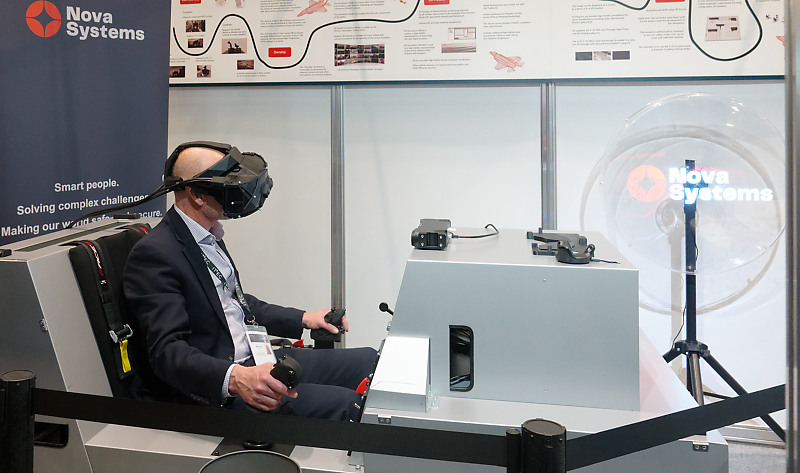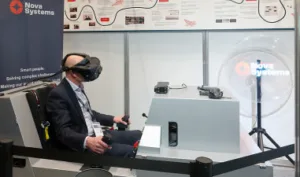I had a chance last week to go to the IT²EC 2022 event at the Excel Centre in London’s Docklands area. It was less busy than the BETT a couple of months ago, but I was hoping that would mean I dodged the bullet of Covid this time! And dodging bullets is one of the topics of this event which focuses on simulation and training in mainly military areas.
I’ve been attending this event for some years. It was noticeable that a few years ago, there was a significant shift in the kind of displays being used, from the projection-based systems including domes, to VR headsets. VR headsets have significant advantages in this area. They are, compared to projection dome systems, cheap and easy to transport to those that need training rather than having to bring trainees to fixed facilities. On this topic, I’ll talk about a discussion I had with VRGineer’s CEO Marek Pol?ák that set the scene very well.
Vrgineers is based in the Czech Republic and has three levels of the specialist flight simulators that it develops and sells. These come in three different grades. At the high end, there are VR-based simulators that are seen, today, as complementary to dome simulators and with each simulator model dedicated to a specific aircraft and with physical controls. The next level down are simulators that can be configured using the displays to emulate a range of different aircraft models with virtual instruments on displays. These simulators can have some motion to make the experience more realistic.
 This is the Vrgineers mid-range system that has mostly virtual controls and instruments. Image:Meko
This is the Vrgineers mid-range system that has mostly virtual controls and instruments. Image:Meko
At the ‘entry level’, there are simple portable simulators that cost ‘as little as $60,000’. That may sound a lot of money, but if you are spending $7 million to $10 million to fully train a military pilot, that’s not a lot. It’s cheap enough that you can put the simulators wherever the pilots are so that they can undertake mission simulation and training without having to spend time getting to a facility.
 The ‘entry level’ systems are ideal for operational simulation and training. Image:Meko
The ‘entry level’ systems are ideal for operational simulation and training. Image:Meko
The firm told us that it sees combined configurations such as one high-end, two mid-range and ten or more of the low cost systems in facilities to optimise the cost/productivity ratio.
The company has done a lot of work to develop its headsets and told us that its challenges are not so much with the headsets, but with the systems needed to drive them with enough performance. Pol?ák said that he thought that the systems were as much as two-three years behind the headsets that the firm has developed in terms of driving speed and resolution.
Over time, we have spoken with players in the high end market such as Varjo about the importance of low latency when using mixed reality. In simulation, full head goggles are the norm, with cameras to support the view of the outside world. However, it takes time to capture, process and transmit the images of the outside world to the user and getting that latency as low as possible is critical to a comfortable and efficient experience. Vrgineers found that a challenge in the early days of developing its headsets and developed its own camera modules with dedicated FPGAs to minimise the time taken.
The firm had its XTAL3 headsets at the event. There are two versions, one which is for mixed reality and integrated with dual 4K cameras and a separate model without cameras for VR only. The company claims a field of view of 170 degrees with up to 90 degrees vertically, although the system uses foveated rendering so that resolution is different (and higher) in the centre while dropping off towards the edges. There are three ranges and the headsets use dual 75Hz 3840 x 2160 LCDs and custom-developed non-fresnel lenses. Depending on the application, resolution and frame rate can be traded off. The headsets have integrated eye tracking and perform automatic IPD adjustment. Options include Ultraleap sensors and can support Steam tracking. They typically cost from $8,900 to $11,000 depending on the options.
Weight of the headset is 700gms (24.7oz) and I thought that they were a bit heavy, although the unit is lighter than the previous version. However, the headset could have been better set up for me, with more time. There was some discrepancy between the virtual and physical controls towards the edges of the display, but again some optimisation might have improved this. There was enough resolution in the foveated region (60 cpd) to read the instruments and my notes said ‘no significant optical aberations’ in my short look.
As I mentioned, Pol?ák forecast that although today the headsets are seen as complementary to domes, in the end he believes that they will replace them as the performance improves. One of the reasons for this is that pilots often find that the headsets are more immersive because everywhere they look there is a simulation and, taking off the headset they can be ‘surprised’ to remember that they are not actually in the virtual world.
(This article turned out to be a bit longer than I expected, so I’ll run the rest of our IT2EC report tomorrow).

